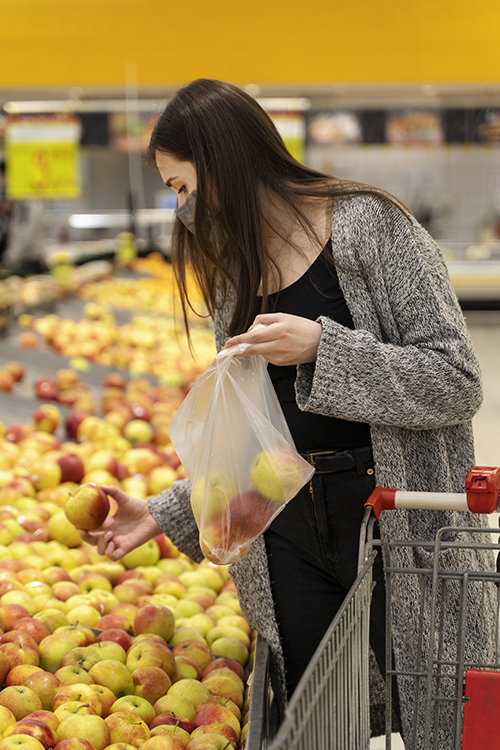Sustainable shopping habits? Eh? What’s happening here? We’re sustainable with our shopping habits, aren’t we? We shop at a supermarket that tells us (through expensive marketing campaigns) that they are on their way to net zero. Furthermore, our go-to website for online shopping explicitly told us that it has dozens of carbon credits. They’re green, aren’t they? That’s why we’re sustainable shoppers because the shops we shop at are sustainable, right?
Wrong.
The sustainable evangelist, me, is here to give you some ideas on how to create some sustainable shopping habits, rather than just being a mindless consumer running rampant among the isles and websites buying everything that takes your fancy because you can afford it. Indeed, just because you can afford it financially doesn’t mean the planet can afford it environmentally. That beautiful greenwashing so many companies engage in to undeservedly earn your trust and make you believe in a false reality adds meaning to that old statement the “road to hell is paved with good intentions“.
Moreover, without our beautiful planet regenerating its ecosystem, money won’t be worth mud because there won’t even be mud. Do I have your attention yet? Good. Welcome to my article on sustainable shopping habits and read on at your leisure, with all the hounds of environmental hell nipping at your heels.

The Pollution Hounds of Environmental Hell.
Source: Freepik and Hiclipart. Edited with photoshop.
What is Meant By Sustainable Shopping?
Sustainable shopping habits mean shopping habits that are sustainable. So what is sustainable when it comes to shopping habits? Showing, not telling, is where you will get the message. Here are a few of my habits that I will share with you.
Sustainable Shopping Habits
- Reusable Shopping Bags: Use reusable shopping bags. In fact, always carry one with you.
- Reusable Fresh Produce Bags: These can be a challenge to find in real life. So you may need to mail-order one.
- Buy Only What You Need: This means there is less landfill and less methane emissions from that waste. It’s also cheaper in your wallet, leaving you with more money.
- Buy Environmentally Friendly: It may cost more now, but in the long run, it will be cheaper for the environment.
- Mindful Transport: Combine trips and do journeys, not jaunts. Get what you need done in one journey, for everything, rather than a short vaunt for a few supplies. In fact, this reduces your carbon footprint and saves you the dollars on fuel.
- Recycle Your Shopping Docket As A Shopping List: I use the back of my receipts as lists.
- Thrift Shopping: For clothing or household goods, consider resupplying at a second-hand store. I do.
- Keep Things: Buy things only if you need them, keeping them for as long as possible. Repair them when necessary. It’s time we faced facts. The planet can’t sustain a population driven by rampant consumerism.
moving forward
So, fellow sustainable evangelists, grab your reusable fruit and veggie bags, along with your sustainable or biodegradable shopping bags, collect the list you scratched out on the back of that blank receipt, and let us all take leaping strides towards the nearest shops to try out our new sustainable shopping habits. No pollution hound shall ever nip at our heels again, now that we have subdued and muzzled them!
Why is it essential that We Develop Sustainable Shopping Habits?
It is essential that we develop sustainable shopping habits to protect our global environment from further degradation. Furthermore, we need to switch to a sustainability mindset to ensure that humanity has a future. It is our duty to share with others this marvellous way of viewing the world. Also, for those of you that have them, your children, and their descendants, will benefit from witnessing your example. It is your children who are inheriting the Earth, and it isn’t fair for them to inherit an environmental debt.
The people of the future need a toolbox full of equipment that individuals can access to transform this world at the microcosmic level. We leave all who come after us a legacy. What that legacy is, good or bad, is up to us. As they say: the choice is yours.
What do you choose?

A woman holding a reusable fresh produce bag.
Source: FreePik.
achieving the United Nations Sustainable Development Goals (SDGs) and how they link to Sustainable Shopping Habits
The following is a quote from the UN.
“The 2030 Agenda for Sustainable Development, adopted by all United Nations Member States in 2015, provides a shared blueprint for peace and prosperity for people and the planet, now and into the future. At its heart are the 17 Sustainable Development Goals (SDGs), which are an urgent call for action by all countries—developed and developing—in a global partnership. They recognize that ending poverty and other deprivations must go hand-in-hand with strategies that improve health and education, reduce inequality, and spur economic growth—all while tackling climate change and working to preserve our oceans and forests.”
(United Nations)
SDG 12 is about “responsible consumption and production“. This is where you, as the consumer, have a crucial role to play in the achieving of this SDG. Sustainable shopping habits are all about responsible consumption. Indeed, the responsibility for the consumption of products remains within the scope of the consumer, you. Furthermore, without you taking proactive steps towards responsible consumption, we won’t accomplish the goal. It is about individuals coming together, doing their bit individually, to make lasting and meaningful changes in this world. Finally, remember, none of us can achieve this goal on our own. We work together as a united planet to do this.
A Thrivable Framework
What is THRIVE? It is the Holistic Regenerative Innovative Value Entity. The word “thrive” also means flourishing. As you can see, the anagram and the definition tie into each other. THRIVE forms the basis for the THRIVE Framework. It is a transdisciplinary, holistic modelling system. The model, itself, is the Systemic Holistic Model (SHM).
The SHM uses back-casting to solve problems. This method uses a way of envisioning the desired outcome and then works out the steps necessary to get there. But wait, there’s more! The SHM uses 12 Foundational Focus Factors (FFFs) to guide the decision-making processes used in back-casting. Furthermore, these FFFs are the pathway, the tactics, to achieve the strategy, which are the SDGs whose ultimate aim is creating a thrivable future for everyone, including you and me.
The SHM is more than a Framework to guide decisions that lead us to achieving goals. The Framework and the FFFs are a way of viewing the world, a mindset, and an understanding. It is a vital way of thinking when it comes to sustainability enlightenment.
Entity Model
Entity model is one of THRIVE’s 12 FFFs. Its aim is to navigate what an entity can do. An entity is anything from a small single-celled organism to the entire cosmos. These models shape the boundaries that outline their limits. THRIVE’s logo, a ciambella chart, outlines two important boundaries for humanity to adhere to. One is a social floor, denoting the minimum for an entity’s survival. The other is an environmental ceiling, where too many resources are taken from the environment.
You are an entity, as am I. We each share the social floor and environmental ceiling with others. It’s the same for all of us. In fact, we all need food and shelter. Furthermore, we all live on the same globe, so the environmental ceiling is also the same. Sustainable shopping habits help us stay within the boundaries, consuming what we need to live, and leaving the rest for the future.
Finite Resources
The FFF of finite resources are resources consumed faster than their production. Yes, our food is renewed reasonably fast. We aren’t talking only about food when it comes to our shopping. We are talking about other resources, such as coal or oil for fossil fuels, or the cotton in our jeans that use nearly 8,000 litres of water, or the metals in our technology. This is where mindful transport, along with keeping and repairing things for as long as possible, comes into play. Developing sustainable shopping habits reduces the consumption of finite resources, giving the future the breathing room it needs.
Regenerative Economy
Our current economy is a linear economy. Products get mined/farmed, created, sold, and disposed of. A regenerative economy, an FFF, focuses on regenerating the environment and using products in a circular fashion. The aims are to reuse, recycle, and repair.
Sustainable shopping habits mean transitioning from a consumer-orientated linear economy to a circular-orientated regenerative economy. For instance, instead of the plastic fresh produce bags you would normally use, you’ve transitioned to reusable fruit and veggie bags. Indeed, when you shop at a thrift shop, you are embracing these principles by reusing something someone else is no longer using. Repairing your technology and ensuring a longer working life drives down the need for finite resources to be consumed.
Systems Thinking
Systems thinking is also a FFF. It is about looking at the big picture to solve the problems. We look at the problems looming. Indeed, they seem large and overwhelming. How can one person do what is necessary to achieve any of it? People say to me all the time that it’s too late to stop the climate crisis. Well, that way of thinking isn’t systems thinking. In fact, it’s linear thinking, which is thinking in a straight line. It’s also very negative thinking and the kind that drama queens adore engaging in.
When you engage in forming sustainable shopping habits, you are developing a solution in your life based on the principle of systems thinking. As the empowered sustainable evangelist, you are taking positive steps to mitigate the issues from your microscopic perspective. Yes, it matters what you do.
Values-Based Innovation
Values-based innovation is about innovating solutions based on the things that we value. These things may be abstract, such as thoughts, principles, ethics, morals, or beliefs. Do you value the planet? It’s the only planet you’ll ever live on. When you form sustainable shopping habits, innovate a solution based on something you value. It’s not just about start-ups; it’s about you and the steps you can take to leave the world better than you found it.
THRIVE And More On Sustainable Shopping Habits And Other Things
As you can see, the various FFFs are all intertwined with each other. I’ve only highlighted the ones that play a major part in sustainable shopping habits. However, don’t let that fool you. Each FFF plays an integral part in our everyday life on the individual, community, society, business, national, and global levels whether we are conscious of it or not.
If you found this article on sustainable shopping habits well worth the read for either education or entertainment, consider continuing your sustainability journey with us. In fact, as a budding sustainability evangelist, our wealth of resources will prove to be your invaluable scripture. Please visit our website, peruse our informative blog, subscribe to our YouTube channel, sign up for our amazing newsletter, follow our fascinating podcast, or attend one of our incredible webinars. Together, we can protect our planet.
